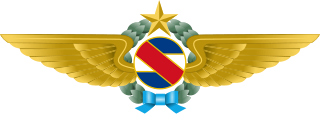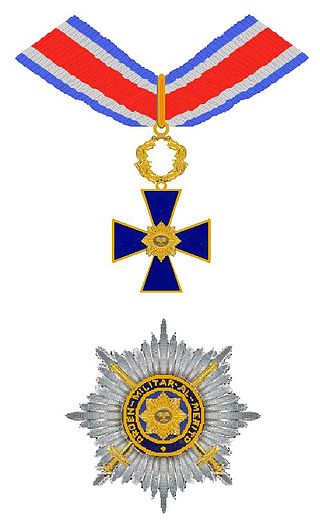
The Uruguayan Air Force is the air service branch of the Armed Forces of Uruguay. Originally created as part of the National Army of Uruguay, the Air Force was established as a separate branch on December 4, 1953. It is the youngest and also the smallest branch of the Armed Forces of Uruguay. In 1977 it was determined that the mission of the Air Force is to conduct strategic and tactical aerospace operations on behalf of the national defense, exercising the sovereignty of the Uruguayan airspace and defending the independence, integrity, constitution and laws of the country. The Air Force must also conduct search and rescue missions and plan, propose, execute and supervise the necessary measures for the development of the aerospace potential, while providing any necessary and possible logistical support during the natural disasters that the country may suffer. Since 1985 this has been always carried out under the command of the President of Uruguay, and according to the Minister of National Defense.

The Chamber of Representatives is the lower house of the General Assembly of Uruguay. The Chamber has 99 members, elected for a five-year term by proportional representation with at least two members per department.

Luis Conrado Batlle y Berres was a Uruguayan political figure.

The following outline is provided as an overview of and topical guide to Uruguay:

The Military Order of Merit of the Companions of Artigas, was a military decoration of Uruguay.

The Electoral Court of Uruguay is the autonomous body which oversees the implementation of electioneering process, such as elections, referendums on laws and constitutional plebiscites in the Oriental Republic of Uruguay.

The president of Uruguay, officially known as the president of the Oriental Republic of Uruguay, is the head of state and head of government of Uruguay. Their rights are determined in the Constitution of Uruguay. Along with the Secretariat of the Presidency, the Council of Ministers and the director of the Office of Planning and Budget, the President is part of the executive branch. In case of absence, their office is exercised by the vice president. In turn, the president of the republic is the commander in chief of the Armed Forces.
The Chilean honours system provides a means for the Government of Chile to reward gallantry, achievement, or service, by both Chileans and non-citizens. The honours system consists of three types of award: orders, decorations and medals. Membership of an Order is conferred to recognise merit in terms of achievement and service. Decorations are conferred to recognise specific deeds of gallantry, bravery, distinguished or meritorious service. Medals are conferred to recognise long and/or valuable service and/or good conduct. Awards to non-citizens are usually only made where the gallantry, achievement or service has advanced Chilean interests in some way. The honours conferred by the Chilean Republic can be divided into two groups: civil and military. Military honours are conferred by the different branches of the Armed Forces of Chile. Civil honours are conferred by the President of Chile or, in some instances, by the government minister relevant to the particular honour.

The Order of Boyacá is the highest peacetime decoration of Colombia. The order is awarded for exceptional service to distinguished Colombian military officers and civilians as well as foreign citizens of friendly nations. Established in 1922, the Order of Boyacá traces its origin to a Cruz de Boyacá that was awarded to the generals who led their forces to victory in the Battle of Boyaca in 1819. Reestablished in 1919 as an award for military personnel the order has undergone revisions and expansions into its current form, with the biggest change happening in 1922 where civilians became eligible to be awarded the Order of Boyaca.

The Uruguayan departments are subdivided into municipalities and, as of 2022, there are 125 municipalities. This second level administrative division system was created by Law No. 18567 of 13 September 2009 and the first municipalities were created in March 2010. In the municipal elections of 2010 municipal authorities were elected for the first time and they assumed office months later.
The system of orders, decorations and medals of Uruguay consists of both military and civilian honours presented by the authorities of Uruguay with the purpose of recognising and rewarding actions or services considered praiseworthy.
The Military ranks of Uruguay are the military insignia used by the Armed Forces of Uruguay.

The Ministry of Social Development of Uruguay (MIDES) is the ministry of the Government of Uruguay that is responsible for proposing, generating and activating national social policies. It is headquartered in the 18 de Julio Avenue in Barrio Cordón, Montevideo. The current Minister of Social Development is Martín Lema, who has held the position since May 3, 2021, after Pablo Bartol was removed from office by the President.
The Office of Planning and Budget (OPP) is a dependency of the Presidency of Uruguay that is responsible for advising the Executive Power in the formulation of national and departmental plans, programs and policies as well as in the definition of the Government's economic and social strategy. It is headquartered in the Executive Tower, Montevideo. The Director of the Office of Planning and Budget is appointed by the President of the Republic at the beginning of the mandate. The position has the same requirements as that of Cabinet Minister and, in practice, has a similar hierarchy. He usually participates in the meetings of the Council of Ministers. The current head is Isaac Alfie, who has held the position since March 1, 2020.

The National Order of Merit of Paraguay is an award given by the government of Paraguay. The award was first established in 1865 and can be given to any person or organization that has contributed in some way to the benefit of Paraguay.

The Uruguayan presidential line of succession is the set order in which officials of the Uruguayan government assume the office of head of state if the incumbent President of Uruguay becomes incapacitated, dies in office, resigns, or is removed from office. The line of succession is set out in Article 153 of the Uruguayan Constitution and follows the order of the Vice President and the Senator of the list most voted for of the political party by which they were elected.
The Medal of Honor for the victorious on the Caseros fields was a military decoration of Uruguay that the Uruguayan government awarded in 1852 to the members of the Uruguayan brigade that took part in the Battle of Caseros and later also awarded to any other Uruguayan citizens that fought in that battle, as a commemoration of the Uruguayan joint victory with the forces of the Brazilian Empire and those of the General Justo José de Urquiza against the forces of Juan Manuel Rosas.
The Decoration Honor of Naval Merit Commander Peter Campbell is an Uruguayan military decoration awarded by the President of Uruguay to civilians, military officers, military units or to institutions, Uruguayan or foreign, as a recognition of the relevant services or works performed to the Uruguayan Navy. This decoration was named after Peter Campbell, an Irish naval officer who became the first commander of the Naval forces created by José Artigas.
Medardo R. Farías was a Uruguayan Army general and pioneer of Uruguayan aviation. In 1950 he was one of the drafters of the project that sought to create an independent Air Force in Uruguay, following the example of many other countries in the world that had confirmed the strategic importance of an independent military aviation, based on the lessons learned during the course of World War II. After the realization of the project in 1953, he became the first General Inspector of the independent Fuerza Aérea Militar, whose position today is equivalent to Commander-in-Chief of the Uruguayan Air Force.











